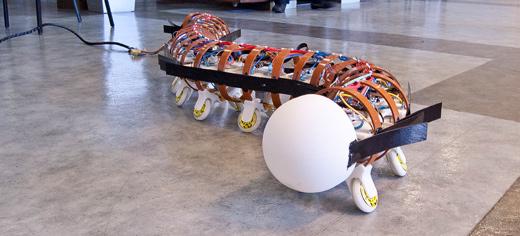 |
| Robot Wormbot by Dr Jordan Boyle of School of Mechanical Engineering |
The Engineering and Physical Sciences Research Council (EPSRC) National Facility for Innovative Robotic Systems, announced on July 17, is part a government drive to improve Britain’s international competitiveness in robotics.
It will give researchers and commercial partners access to a world-beating suite of technologies including the latest 3D printing technology, a high-precision cutting system that fires a laser beam through a jet of water and “micromanipulators” for assembling tiny robots.
The research of the new facility will build on the University’s existing strengths in robotics for surgical applications, patient rehabilitation, prosthetics, and exploration.
Dr Rob Richardson, Director of the Institute of Engineering Systems and Design at the University’s School of Mechanical Engineering, said: “We looked at the most innovative robots being made around the world and made sure that the facility would have the capability to build them. We then added a suite of equipment that will enable us to build robots using new and innovative techniques. We will be building new robots that can do new things in areas that matter to people’s lives.”
Dr Richardson added: “The key to the capability of this new facility is its ability to integrate hard and soft mechanical structures with electric systems and computing in incredibly compact and complex ways. The human body is built from rigid bones, soft tissue, muscles, sensory organs and communications pathways, all squeezed into the smallest possible space. We hope to be able to use this inspiration to build robots with ever more integrated parts and increased capabilities.”
The new 3D printer will allow researchers to “print” large and small components of virtually any shape from digital models using multiple materials.
A “microjet” cutter, which focuses a laser beam through a jet of water, will allow extremely precise cutting of hard and soft materials from diamonds to thin plastic film. Another set of equipment will allow researchers to print circuits onto the robots in three dimensions, rather than relying on conventional flat circuit boards.
A ground-breaking suite of electronic test and measurement equipment will enable the creation of improved and miniaturised networked robots along with a new generation of miniature microwave and ultrasound sensors for surgical robots.
The new facility will also be equipped with a 3D visualisation studio, excellent conventional machining and micromanipulators to assemble miniature robots that would be beyond the capability of the human hand.
Dr Richardson said: “Leeds already has a strong reputation for applied robotics. While most other institutions do a lot of theoretical work, we have a track record of building bespoke robots that push the boundaries of what can be done physically.”
The University’s robotics research already spans a wide range of applications from minimally invasive surgery to the exploration of ancient pyramids. One device with feet modelled on tree frogs is being designed to crawl inside patients’ bodies during abdominal surgery. Another robot will travel inside the colon to screen for cancer, while a new project is looking at ways to develop more “intelligent” prosthetics that anticipate and work with users’ body movements to improve function.
An international team, academically led by Dr Richardson, developed a robot that was able to explore previously inaccessible tunnels in the Great Pyramid of Khufu in Egypt, uncovering mysterious markings apparently left by its builders.
Other exploratory robots include an electric “mole” designed to dig through rubble in disaster zones and a giant worm-bot that mimics the nervous system of a real nematode worm.
The EPSRC is spending £2.6 million on equipment for the new facility, part of a £85-million nationwide investment in capital equipment to support existing research into robotics and autonomous systems, advanced materials and energy storage. The University will invest a further £1.2 million in equipment and lab improvements and industry will contribute £0.5 million, resulting in a total investment of £4.3 million.
Announcing the new funding, the Minister for Universities and Science David Willetts said: "For Britain to get ahead in the global race we have to back emerging technologies and ensure our universities have the latest equipment. This capital investment will help scientists make new discoveries and take their research through to commercial success. It will drive growth and support the Government’s industrial strategy."
Professor Ian Robertson, Head of the University’s School of Electronic and Electrical Engineering, said: “This investment is wonderful news not only for the University’s research teams but for Britain’s ability to compete internationally in robotics research. The facility will bring together a suite of cutting-edge technologies in one place that will be the envy of institutions across the world.”




0 Comments